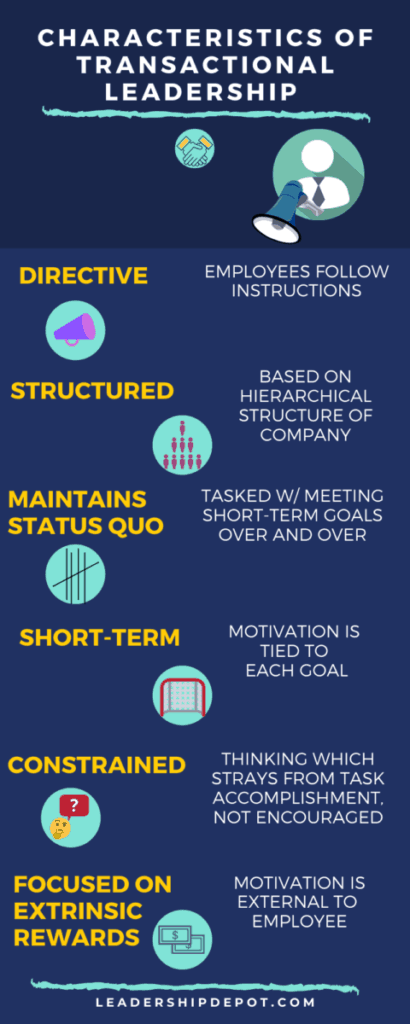Transactional leadership is a style of leading or management that is focused on consequences.
The transactional leadership style encompasses two main factors:
- a contingent consequence system — rewards and punishments (or lack of rewards) — and
- interventional management, also called “management by exception.”
It is based on concept that the leader provides clear expectations and clear outcomes based on performance. It’s directive in nature, where the outline of the goals come from the top down.
It’s centered around the leader providing rewards which appeal to the self-interest of the employee. Power is assumed by the leader in exchange for these rewards. This style of leading relies on an external form of motivating individual, often money.

Let’s take a look at the factors involved in more detail.
Factor 1: Consequences
Transactional leaders set clear goals and communicate them with the team they manage. Along with the goals, there is an understanding of the rewards in place, for the effort, the commitment, and/or for achieving the goal. Negative consequences are also either communicated or implied if the effort, commitment or the reaching of the goal doesn’t take place. (The negative consequence doesn’t have to be a punishment; it can just be the absence of reward.)
Factor 2: Interventional Management
This involves maintaining a state of status quo. Employees are expected to accomplish tasks toward the goal and the leader interjects when employees are not on task, or not headed in the direction of the goal. The manager get involved to adjust trajectory so that the team or individual will be more in line with meeting the goal.
Two prominent leadership researchers, Bernard Bass and Bruce Avolio, developed a theory about the relationship between transactional, hands-off, and transitional leadership styles back in the 1990s. They called it Full-Range Leadership Model (FRLM), where the premise of the theory is that leaders vary between these styles based on circumstances in the workplace.
Benefits of Transactional Leadership
- Transactional leadership is generally clear-cut, meaning that the objectives are clear and the rewards are set to be attainable. That’s a benefit to both
the leader and the employees.
- Because it’s task-driven, it’s measurable.
- It benefits those individuals who can understand the goal, have personal initiative to accomplish the task(s), and who appreciate structure and are willing and able to follow the steps to complete the objective. It can also provide employees a shorter-term satisfaction than other leadership styles that don’t focus as much on accomplishing tasks.
Potential Drawbacks of Transactional Leadership
- Since transactional leaders are focused on having the team complete tasks, there is not much incentive for creative thinking. Because of this, the transactional leadership style tends to maintain existing systems within the organization versus helping to take the organization to the next level.
- Individuals who have a lot of personal initiative, desire to think creatively and have the ability to put ideas into action, often won’t have that capability in this type of environment, due to the structured nature of this environment.
- Performance may be a direct result of the perceived value of the reward by team members. The reward must always be greater than the penalty in the mind of each worker or else there may be no incentive for the worker to perform as expected. That means that the leader has to be correct in assessing each worker’s perceived value of the reward and penalty.
- Success of this leadership style is directly tied to the leader. The key to it working is in the abilities of the leader with this style.
Transactional Leadership Examples
Many examples of this style of leadership exist across industries. However, two industries where you’ll see this type of leadership prevalent are within sales and manufacturing.
- Transactional leadership is inherent in commission-based sales jobs; the more sales, the more commission a salesperson can usually make. It’s also prevalent in non-commissioned sales roles. The more sales, the better and the more rewards sales team members might see. They make a sale, then go out and do it again.
- Manufacturer have hierarchy. They have structure. There is an expectation of certain quality and certain output. Line workers are often motivated through an external reward system: provide THIS quality and THIS quantity, with a maximum of THIS number of safety problems, and you get THIS.
One more example is within organizations where competition between departments or within departments to meet deliverables is put into place. In these cases, rewards can be bragging rights, monetary incentives, and / or recognition.
The benefits of the transactional leadership style have led organizations to realize greater profits for years. This style continues to do so, which is why it’s alive and well in organizations within numerous industries today. It works well at lower levels of an organization, where accomplishing tasks to meet company objectives is key; upper levels consist of those who are able and want to provide more vision and broad direction for the business.

